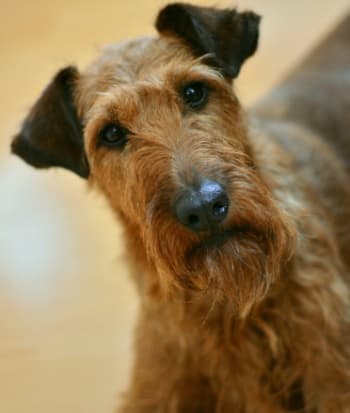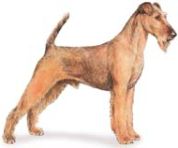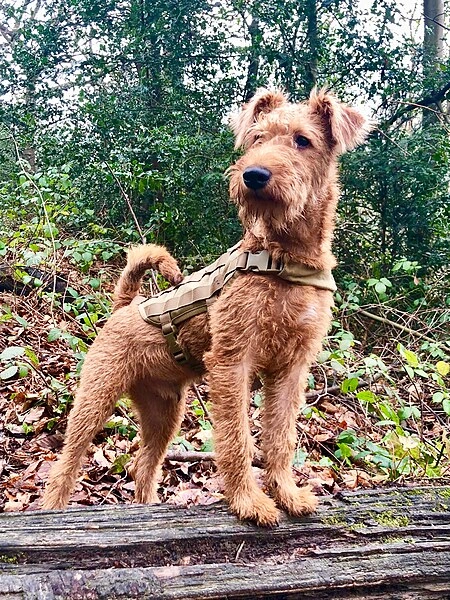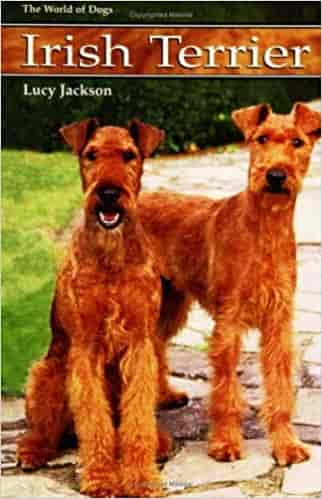Irish Terrier Breed
A Spirited Dog Of Unrelenting Courage!
The Irish Terrier breed, which was (not surprisingly) developed in
Ireland, has very old roots, although its exact origins are unclear.
However, speculation has it that the Black and Tan Terrier and the
Wolfhound are among its ancestors.
 Courtesy Conger Designs
Courtesy Conger DesignsThis breed first appeared in the show ring in 1875, though dogs greatly
resembling them have been seen much earlier in paintings of 17th
century.
Originally, the Irish Terrier worked on the farm as a tenacious ratter and guardian of family and property.
He also did service in World War 1 as a messenger and guard.
As a hunting companion, he is very capable of tracking and retrieving his quarry both over land and in water.
The Irish Terrier is distinctive in appearance by his red coat and ever
alert expression. There is a similarity to the Fox Terrier in his bodily
structure, but the Irish is taller and longer-legged.
Irish Terrier Breed Characteristics
Both highly spirited and courageous, this dog is headstrong when in
pursuit of its objectives. The Irish Terrier breed's tenacity and
boldness has earned them the moniker of Daredevils.
Irish Terriers are intelligent dogs and extremely loyal to their family, but they
need strong leadership. If you acquire an Irish Terrier, it is very
important to establish yourself as the "alpha"
presence in his life so that there is no ambiguity about who's the pack
leader!
Kind/Firmness and consistency is recommended in training
this breed, as well as early socialization to balance their strong
protective instincts, and temper potential dog-aggressive traits.
Puppy school is just about a must for the Irish to start interacting with other dogs.
This Terrier is a spirited and gutsy Irish dog known for its playfulness and strong affection for his family.
Physical Stats And Coat Care

Height: 18 inches
Weight: 25-27 lbs.
Color variations: Red, Red-Wheaten, Golden Red
The double coat of the Irish Terrier is harsh, wiry and weatherproof. It does not require a lot of upkeep and shedding is
minimal, but hand stripping of the coat is needed periodically to
maintain its attractiveness and color. Otherwise, tidy the coat about
once a week or more with a good slicker brush.
Owners can have this done professionally or try it themselves with this excellent Pet Stripping tool.
Get your Irish used to having his teeth brushed, daily is ideal, but as often as you can. Dental care is a very important part of a dog's health and if started early can actually be enjoyed by your pet. Really!
Inspect ears about once a week looking for any changes such as redness or irritation. If you see any signs of infection, check this page for help. Otherwise, clean when necessary with an ear cleaner for dogs. Nails may need clipping if you can hear them as your dog walks about.
 Courtesy Andrew Clark
Courtesy Andrew ClarkHealth Notes
If you are interested in getting an Irish Terrier puppy, seek out a reputable breeder who will have crossed all the i's and dotted all the t's to have the best chance for healthy puppies. You can usually find a professional breeder through the AKC marketplace.
That done, you should still be aware of what health issues are associated with the breed even though Irish Terriers are considered generally healthy dogs. Having this information at hand, will prepare you for asking questions when you meet the breeder.
So here are some of the condition that may affect the breed during its lifetime:
- Cataracts: This is a cloudiness that develops in the eye lens. Cataracts can often be removed if caught early.
- Cystinuria: A condition that causes bladder stones. Although uncommon, it does seem to affect this breed more than others and there is no genetic test.
- Hyperkeratosis: This condition causes a hardening and thickening of the skin around the nose and paws. A genetic test is now available to help avoid this during breeding.
- Hip and elbow dysplasia: Common orthopedic problems that affect the hips and elbows.
Irish Terriers have a potential life span of between 13 to 15 years given the benefit of good nutrition, exercise and regular veterinary oversight.
How Active Is the Daredevil?
The Irish Terrier breed is very active with lots of stamina. He likes to have long daily walks, but should not be taken out
off-leash.
He will greatly enjoy the chance of a free run if a secure area is available, but be warned that
he is a clever escape artist with a strong prey drive.
Ideal Living Space
The Irish Terrier can do well in either apartment or house, providing sufficient opportunity for exercise is available.
With a breed as spirited and full of vigor as the Irish, a securely fenced yard for play and training is the most ideal.
Suitable Breed For Children?
This dog enjoys the games and high-spirited play of children. Does best with older children who are mature
enough to handle a high energy dog safely and with consideration.
As always, no matter what the breed, activities between pets and children should be supervised by an
adult.
Seniors or Less Active Homes?
Although a very protective companion, the Irish Terrier dog breed would be too challenging and energetic for an owner or family that enjoys a more sedentary lifestyle.
On the other hand, active seniors may enjoy the Irish Terrier.
Book Recommendation
Covers origins and early history, the breed standard, selection, advice for new owners, care and basic
training, feeding and health care, champions, kennels and breeders. Full color pictures.
Before You Go...
If you like the content of this page, as well as others on my site, please give it some love by clicking on the heart in the lower right hand corner. This helps me keep providing enjoyable and useful content.
Thank you.
Resource: The Irish Terrier Club of America provides extensive information about the breed including referrals for puppies as well as the opportunity to give your heart to a Rescue.
Puppy Image: Creative Commons Attribution 2,0 generic

